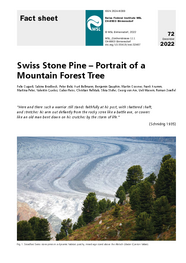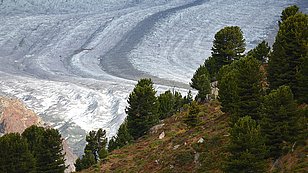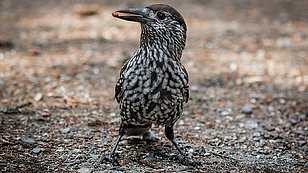Swiss stone pine – portrait of a mountain forest tree

Felix Gugerli, Sabine Brodbeck, Peter Bebi, Kurt Bollmann, Benjamin Dauphin, Martin Gossner, Frank Krumm, Martina Peter, Valentin Queloz, Gabor Reiss, Christian Rellstab, Silvia Stofer, Georg von Arx, Ueli Wasem, Roman Zweifel
Gugerli F., Brodbeck S., Bebi P., Bollmann K., Dauphin B., Gossner M., … Zweifel R. (2022) Swiss stone pine – Portrait of a Mountain Forest Tree. WSL Fact sheet 72. Birmensdorf: Swiss Federal Institute WSL.16 p. doi.org/10.55419/wsl:32467
Brief summary ¶
The Swiss stone pine (Pinus cembra L.) stands out among the pine tree species of the Alpine region. It “crowns” the timberline, its altitudinal range explaining why it is sometimes also known as the “Queen of the Alps”. The stone pine also stands out for various biological characteristics. As well as its capacity for physiological adaptation, its interaction with the spotted nutcracker (Nucifraga caryocatactes) as a seed disperser is of particular note. And then the Swiss stone pine also plays an important ecological and economic role as the main tree species of the stone pine-larch forest community, especially in the Alps. Rapid climate change does pose a major challenge, however. The long-lived Swiss stone pine can only move up the slopes slowly in response to the increasing competition as other tree species also migrate to higher altitudes.
Links ¶
Related fact sheets ¶
Contact ¶
Order a WSL Fact Sheet ¶
Send orders to: e-shop(at)wsl.ch
Please note that the order quantity for fact sheets is limited to 30 copies. Any duty costs for shipping abroad must be paid by the recipient. Larger orders are only possible on request and against payment of a contribution towards expenses (e-shop(at)wsl.ch).
Imprint ¶
Managing Editor ¶
Martin Moritzi
Swiss Federal Institute WSL
Zürcherstrasse 111
CH-8903 Birmensdorf
martin.moritzi(at)wsl.ch
Publisher ¶
Swiss Federal Institute WSL
Zürcherstrasse 111
CH-8903 Birmensdorf
The WSL is a research institute of the ETH Domain.
Concept ¶
The Merkblatt für die Praxis (ISSN 1422-2876, digital ISSN 2296-4428) summarises key findings from WSL research and provides guidelines for best practice. The series is aimed at forestry and nature conservation groups, authorities, schools and interested laypersons.
French editions are published in the series Notice pour la practique (ISSN 2813-6071). Italian and English editions appear occasionally in the series Notizie per la pratica (ISSN 1422-2914) and WSL Fact Sheet (ISSN 2624-8069).


